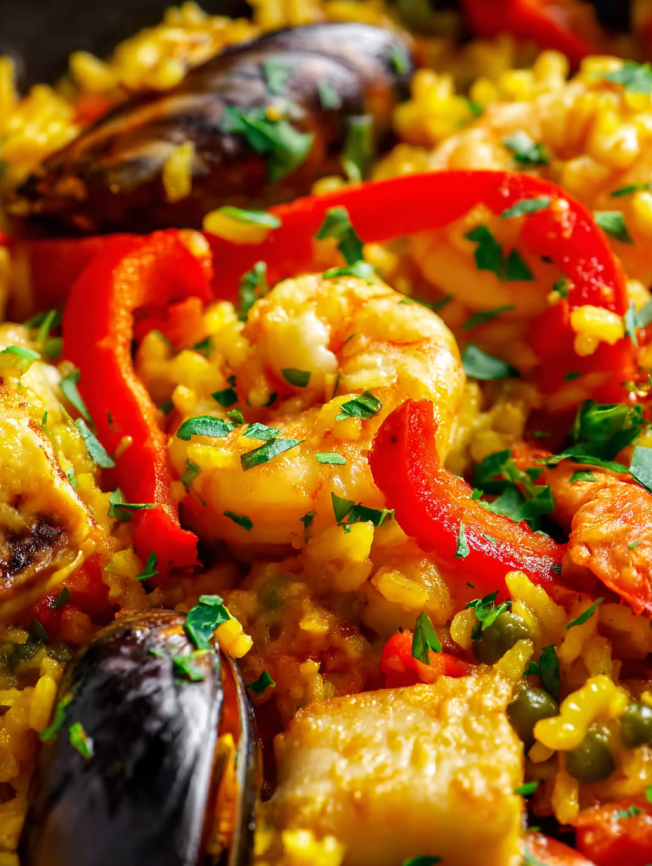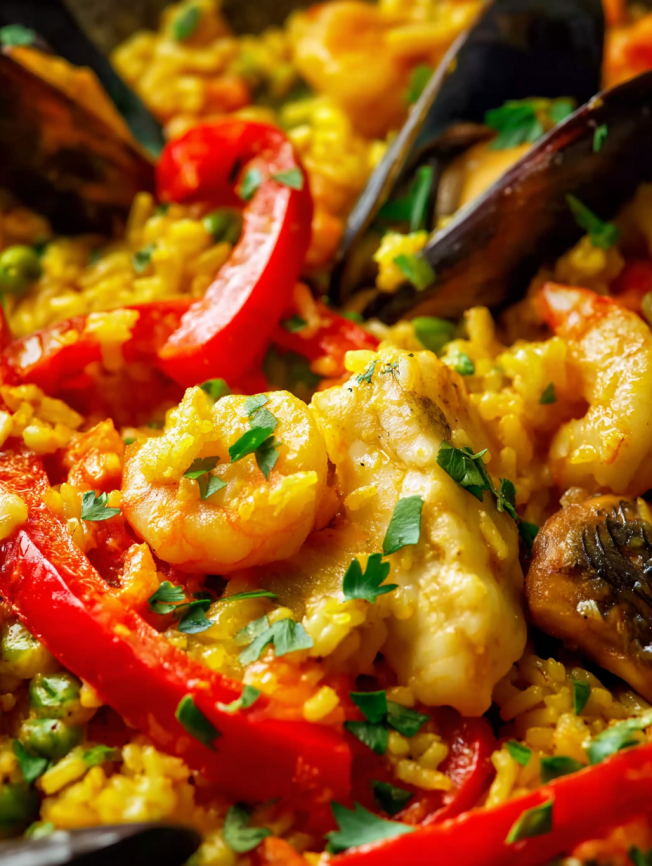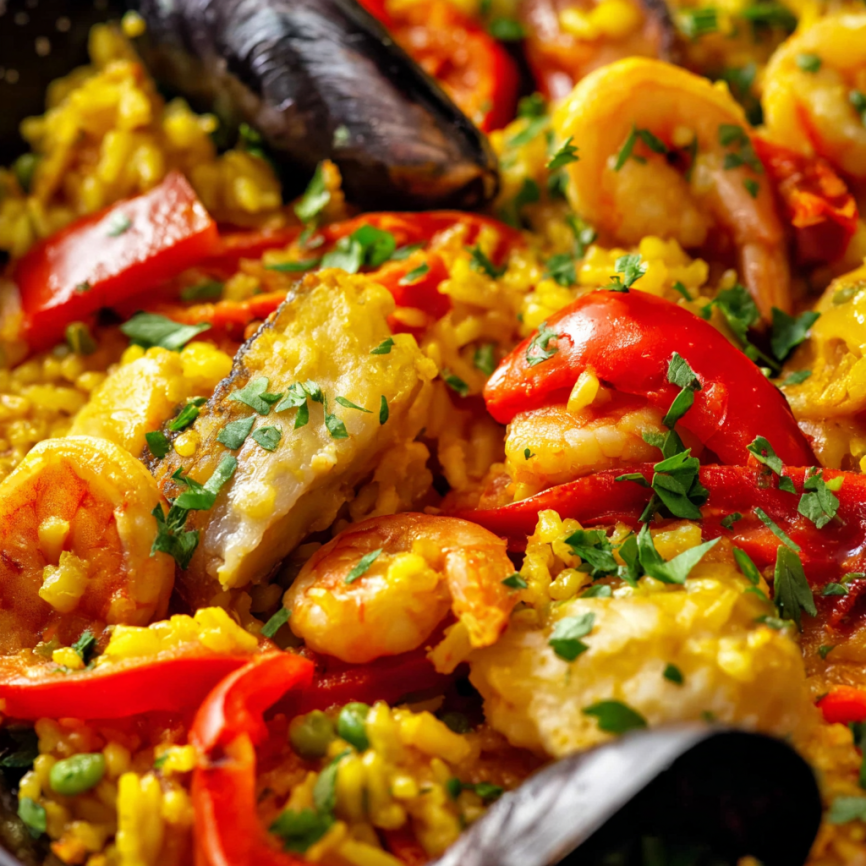The aroma of saffron-scented rice still takes me back to my grandmother’s kitchen in Valencia, where I first learned that paella is more than just a dish – it’s a celebration. Growing up, Sunday gatherings meant the whole family would crowd around her massive paella pan, watching as she layered flavors with the precision of an artist. This recipe carries forward that tradition, bringing the authentic taste of Spain to your home.
Every grain of rice in this paella tells a story of coastal Spanish cuisine, where land meets sea in perfect harmony. The golden hue from precious saffron, the tender chicken and seafood, and the aromatic vegetables create a symphony that has been perfected over generations.
Why This Paella Recipe Will Transport You to Spain
Authentic Traditional Technique
This recipe follows the time-honored methods passed down through Spanish families for centuries. Unlike many adaptations, it respects the traditional layering process that creates the perfect texture and allows each ingredient to shine while harmonizing with the whole.
Perfect Balance of Land and Sea
The combination of chicken, seafood, and vegetables represents the essence of Spanish coastal cooking. Each protein cooks at its optimal time, ensuring the chicken remains juicy, the seafood stays tender, and the vegetables maintain their vibrant character.
Achievable Restaurant Quality
While paella has an intimidating reputation, this recipe breaks down the process into manageable steps. With proper timing and technique, you’ll achieve the coveted socarrat – the slightly crispy bottom layer that Spanish cooks prize above all else.
Impressive Presentation
Few dishes create the visual impact of a properly prepared paella. The vibrant colors, aromatic steam, and communal serving style make it perfect for entertaining or special family occasions.
Ingredients
Prep Time: 15 minutes
Cook Time: 45 minutes
Total Time: 1 hour
Servings: 6 people
Base Aromatics
- 2 tablespoons olive oil
- 1 large onion, chopped
- 6 large garlic cloves, finely chopped
- 1 small red bell pepper, diced into small pieces
- 4 large tomatoes, chopped
Protein Selection
- 4 large boneless skinless chicken thigh fillets, cut into bite-sized pieces
- 10-12 mussels, scraped and cleaned properly
- 8 ounces calamari rings
- 21 ounces shrimp (preferably with tails on)
Rice and Liquid Components
- 2 cups medium grain rice or jasmine rice
- 3¾ cups low sodium chicken broth or homemade fish stock
- ½ cup dry white wine (Sauvignon Blanc or Pinot Grigio)
- ½ cup frozen peas
Essential Seasonings
- 1 teaspoon saffron powder or saffron threads
- 1 teaspoon paprika (sweet or smoked)
- ½ teaspoon garlic powder
- ½ teaspoon onion powder
- Salt and pepper to taste
Garnishes and Finishing Touches
- 2 tablespoons fresh flat-leaf parsley, chopped
- 1 tablespoon fire-roasted bell pepper strips
- Extra olive oil for drizzling
Traditional Accompaniments
- Lemon wedges
- Crusty Spanish bread
- Alioli (garlic mayonnaise)
- Spanish olives
Step-by-Step Instructions
Building the Sofrito Base
Heat olive oil in a large non-stick pan, well-seasoned skillet, or traditional paella pan over medium heat. The pan should be wide enough to allow the rice to cook in a relatively thin layer. Add the chopped onion, garlic, and red bell pepper, cooking until the onion becomes transparent, approximately 3 minutes.
This sofrito base is crucial to authentic paella flavor. Stir frequently to prevent burning, and ensure the vegetables develop a sweet, caramelized flavor that will permeate the entire dish.
Searing the Chicken
Add the chicken pieces to the pan and sauté until they turn golden brown on all sides. This browning process, known as the Maillard reaction, creates deep, complex flavors that distinguish restaurant-quality paella from home versions that skip this step.
Once the chicken achieves a beautiful golden color, add the chopped tomatoes along with salt and pepper to taste. Cook for 5 minutes, allowing the tomatoes to release their liquid and begin creating a rich sauce that will coat the rice.
Adding Wine and Seafood
Pour in the white wine, followed by the cleaned mussels and calamari rings. The wine adds acidity that balances the richness of the dish while helping to steam open the mussels. Allow everything to cook for 5 minutes, letting the wine evaporate to half its original quantity.
During this stage, the mussels should begin to open, and the calamari will start to become tender. Discard any mussels that refuse to open after cooking.
Incorporating Rice and Aromatics
Pour in the chicken broth or fish stock, then add the rice, frozen peas, and precious saffron. Mix all ingredients gently but thoroughly, ensuring the rice is evenly distributed throughout the pan. The saffron will begin to release its distinctive golden color and earthy aroma.
Bring the mixture to a rolling boil, then reduce the heat to medium-low. Cover the pan and allow most of the liquid to absorb into the rice while stirring occasionally to prevent sticking and burning on the bottom.
Final Protein Addition
When the rice is almost cooked through but still has a slight bite, add the shrimp, mixing them gently through the rice. Cover again and continue cooking until both the prawns and rice are completely cooked. The shrimp should turn pink and opaque throughout.
Creating the Perfect Finish
Once everything is perfectly cooked, remove from heat and sprinkle with fresh chopped parsley. Arrange the fire-roasted bell pepper strips over the top for both visual appeal and enhanced flavor. Finally, drizzle a small amount of high-quality olive oil over the surface before serving.

Serving Suggestions
Traditional Spanish Style
Serve directly from the paella pan, placing it in the center of the table with serving spoons around the edges. This communal style encourages conversation and creates an authentic Spanish dining experience.
Individual Plating
For more formal occasions, carefully portion the paella onto individual plates, ensuring each serving contains a good mixture of all the proteins and vegetables. Garnish each plate with a lemon wedge and a sprig of fresh parsley.
Accompaniment Pairings
Serve alongside crusty Spanish bread, a simple green salad dressed with sherry vinegar, and perhaps some Manchego cheese and Spanish olives as appetizers.
Recipe Variations
Vegetarian Paella
Replace all proteins with seasonal vegetables such as artichoke hearts, green beans, lima beans, and roasted red peppers. Use vegetable stock instead of chicken broth for a completely plant-based version.
Meat Lover’s Paella
Add Spanish chorizo, diced pork, or even rabbit (traditional in Valencia) alongside the chicken. Each meat brings its own unique flavor profile to the dish.
Seafood-Only Paella
Eliminate the chicken and increase the variety of seafood. Consider adding clams, scallops, langostinos, or firm white fish. This version is particularly popular in coastal regions of Spain.
Paella Mixta
The most popular variation combines chicken, seafood, and vegetables in equal proportions. This version offers the best of all worlds and is perfect for feeding a crowd with diverse preferences.
Make-Ahead Tips
Prep Work Strategy
Clean and prepare all seafood up to 24 hours in advance, storing them separately in the refrigerator. Chop vegetables and measure seasonings the day before to streamline the cooking process.
Stock Preparation
Homemade fish or chicken stock can be prepared up to 3 days ahead and stored in the refrigerator. Quality stock makes a significant difference in the final flavor of the paella.
Partial Cooking Method
While paella is best served immediately, you can prepare the dish up to the point of adding the seafood, then finish it just before serving. This technique works well for entertaining larger groups.
Reheating Guidelines
If you must reheat paella, do so gently in a low oven (300°F) covered with foil, adding a splash of stock to prevent drying out. However, the texture will never be quite the same as freshly made.
Essential Cooking Notes
Seafood Selection Tips
Fully shelled shrimp is traditional in Spanish paella, but many home cooks prefer peeled, tail-on shrimp for easier eating. Choose whatever style your family prefers, but ensure the shrimp are fresh and properly deveined.
Protein Substitutions
If seafood isn’t available or preferred, replace it with additional chicken thigh fillets. Chicken thighs remain more tender and flavorful than breasts during the longer cooking process.
Rice Variety Importance
Medium grain rice or jasmine rice yield the best results because they absorb liquid well while maintaining their structure. Avoid long-grain rice, which can become mushy or fail to achieve the proper texture.
Fire-Roasted Pepper Technique
Create your own fire-roasted peppers by placing them directly over a gas flame until they char and the skin begins to crease and peel. This adds an authentic smoky flavor that enhances the overall dish.

Frequently Asked Questions
Q: What’s the most important ingredient in paella? A: Saffron is absolutely essential – it provides both the characteristic golden color and the distinctive earthy flavor that defines authentic paella. Don’t substitute with turmeric, as the flavor profile is completely different.
Q: Can I make paella without a paella pan? A: Absolutely! A large, wide skillet or even a large roasting pan works well. The key is using something wide enough to cook the rice in a relatively thin layer for even cooking.
Q: How do I know when the paella is perfectly cooked? A: The rice should be tender but still have a slight bite, the liquid should be absorbed, and you might hear a gentle crackling sound as the bottom layer begins to caramelize – this is the prized socarrat.
Q: Can I use bomba rice instead of medium grain? A: Yes! Bomba rice is the traditional Spanish rice for paella. It absorbs more liquid than other varieties, so you may need to add extra stock. It’s available at specialty stores or online.
Q: What wine pairs best with paella? A: Spanish wines like Albariño, Verdejo, or a light Tempranillo complement paella beautifully. The wine should be crisp enough to cut through the richness while not overpowering the delicate saffron flavors.
Q: How do I clean mussels properly? A: Scrub the shells under cold running water, remove any beards (the fibrous threads), and discard any mussels that are already open or have cracked shells before cooking.
Q: Can I make paella for a larger crowd? A: Certainly! Double or triple the recipe as needed, but you’ll need a larger pan and may need to adjust cooking times slightly. The key is maintaining the proper rice-to-liquid ratio.
Q: What’s the best way to achieve the socarrat? A: In the final few minutes of cooking, increase the heat slightly and listen for a gentle crackling sound. You should smell a toasty aroma but no burning. This creates the coveted crispy bottom layer that Spanish cooks treasure.
Nutrition Information (per serving):
- Calories: 615
- Protein: 51g
- Carbohydrates: 73g
- Fat: 11g
- Fiber: 4g
- Sodium: 332mg

